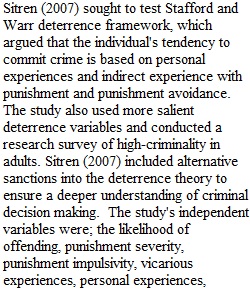


Q Instructions for M1 Theory Application (TApp) Essay Each theory application essay looks at two aspects: 1) empirical testing of the theory 2) application of the theory to policy or practice in criminal justice. Part 1 Using Google Scholar or university library databases, find a recent empirical article (published within the last 10-15 years) that tests some aspect of rational choice or deterrence applied to criminal justice issues. Feel free to use keywords like "rational choice and delinquency" or "deterrence and white collar crime" (or whatever other type of crime you are interested in with regard to deterrence). a. Copy and paste the article reference in APA format (click " button in Google Scholar or "Cite" button in library databases to obtain a reference). b. Explain how the authors measured rational choice or deterrence variables (independent variable) and what type of crimes or delinquent behavior was measured as the outcome (dependent variable). c. In a nutshell, what were the results of this study? d. What do you think the results of this study imply for the theory (or a specific component of the theory)? Part 2 Write a short (2-3 paragraphs) essay discussing which criminal justice policy or program seems most compatible with rational choice theory and how specifically the key concepts and propositions of the theory align with or inform the main parts of the policy/program. Clearly indicate Part 1 and Part 2 of your essay! Save the file as a Word document and upload it to the TurnItIn link in Module 1. TurnItIn is a system that checks for plagiarism so make sure you don't use any phrases or sentences from other sources (except for copying and pasting the article reference in APA format).
View Related Questions